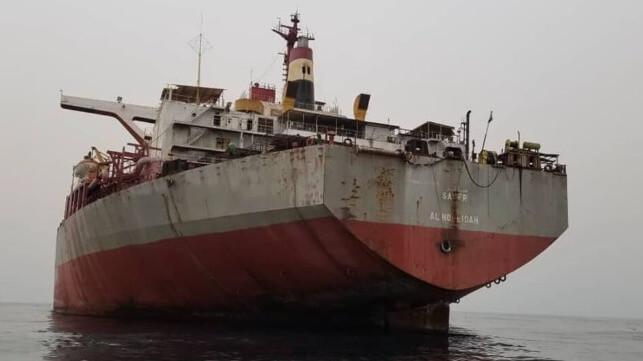UN Asks Public to Help Fund Cleanup of Decaying Yemeni FSO Safer

Faced with the need to come up with $144 million to remove oil from the decaying FSO Safer and buy a new replacement vessel for Yemen's Houthi rebels, the United Nations has turned to crowdfunding. The UN has launched a social media campaign to help fund the high-stakes project, which has taken on more urgency every year since the Yemeni civil war broke out in 2015.
The UN warns that the Safer could pollute a wide swath of the Red Sea if its million-plus barrels of oil were released. The ancient single-hull FSO contains about four times as much crude as the amount spilled in the Exxon Valdez disaster, and it is at high risk of a casualty. It was last drydocked in 1987; it has barely been maintained since the start of the war; tank inerting ceased years ago; and it has already suffered water ingress once in its engine room.
The UN has secured pledges totaling $60 million from donor nations, but it will need at least $80 million to carry out the task of offloading the FSO's oil and cleaning its tanks - not counting the extra $64 million it will need to satisfy the full terms of its deal with the Houthis. The crowdfunding plan aims to collect $5 million to help fill the $20 million gap between current nation-state pledges and the cost of salvage.
According to the IMO, the salvage plan incorporates two parallel tracks. First, an emergency operation would be carried out to transfer the oil to a temporary VLCC over the course of four months, resolving the urgent problem of a potential spill. Both the FSO Safer and the temporary vessel would remain in place until all the oil is transferred to a new, permanent FSO. Only when this sequence is completed will the Safer be towed off and sold for scrap. The timeline calls for the installation of the new FSO within 18 months, but UNDP said at a pledging conference that it plans to charter a temporary storage VLCC for no less than five years.
The oil in the Safer and the demolition value of the ship would be enough to cover the cost of the salvage operation at current spot prices, even assuming a healthy discount. However, the plan as announced does not contemplate using the value of the Safer's hull ($20-plus million) or the cargo ($100-plus million) to pay for the operation and the new replacement vessel.
"My particular concern is really we need to finish this operation by the end of September to avoid the turbulent winds that start in the latter part of the year . . . increasing the risk of a break-up, and also increasing the risk in conducting any operation,” said UN Humanitarian Coordinator David Gressly. "If indeed there were a spill, the estimates that we’ve received on the cleanup alone would be $20 billion. A $20 million additional investment today to save $20 billion seems like a very easy business case to make."
